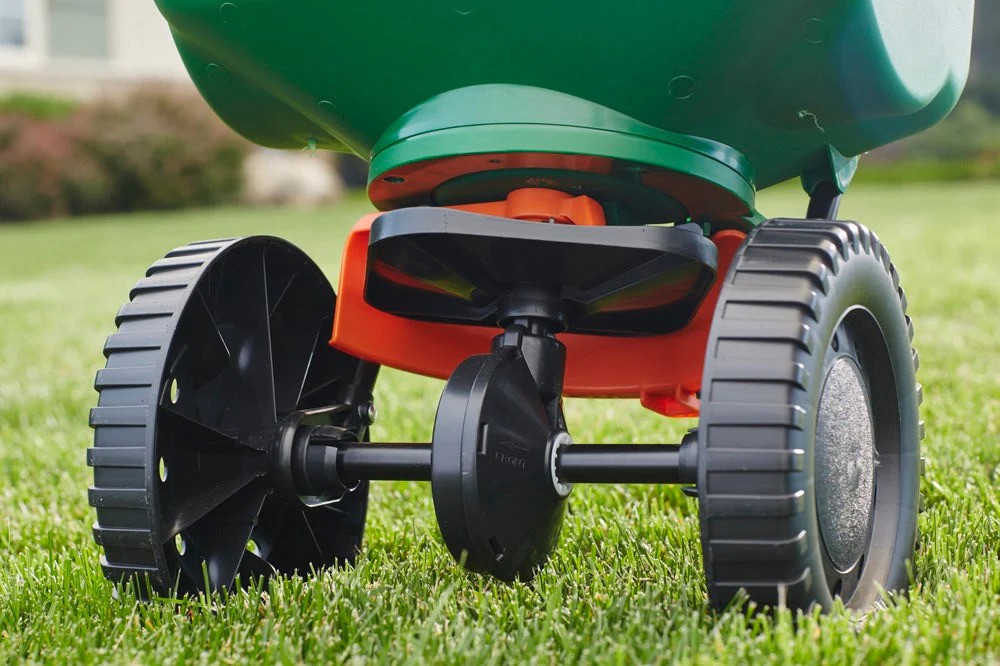If you’ve been battling pests in your garden or lawn, you’ve probably heard about diatomaceous earth. This natural, non-toxic substance is gaining popularity among homeowners and gardeners for its effectiveness in pest control. But can you use a broadcast spreader with diatomaceous earth?
This post will explore this question and provide a comprehensive guide to help you get the most out of your diatomaceous earth application.
What is Diatomaceous Earth?
Explanation of Diatomaceous Earth
Diatomaceous earth (DE) is a soft, crumbly sedimentary deposit formed from the fossilized remains of diatoms, a type of hard-shelled algae. It’s composed mainly of silica, a common element found in the Earth’s crust. The fine powder has microscopic sharp edges that can pierce the exoskeletons of insects, causing them to dehydrate and die.
Common Uses in Gardening and Pest Control
DE is widely used in gardening and pest control due to its effectiveness against a broad range of pests. It can be sprinkled around plants to deter slugs, ants, and other crawling insects. Additionally, it can be used indoors to control bedbugs, fleas, and other pests without harming humans or pets.
Benefits of Using Diatomaceous Earth
- Non-Toxic: Safe for humans and pets when used correctly.
- Effective: Kills a wide range of pests by physical means.
- Multi-Purpose: Can be used both indoors and outdoors.
- Natural: No chemicals or synthetic agents involved.
Can You Use a Broadcast Spreader with Diatomaceous Earth?
Yes, you can use a broadcast spreader to apply diatomaceous earth. It’s an efficient way to cover large areas evenly, ensuring effective pest control.
Explanation of Why a Broadcast Spreader Can Be Used
A broadcast spreader is designed to distribute granular substances like fertilizer, seeds, and, yes, diatomaceous earth. It works by scattering the material over a wide area, making it ideal for large lawns and gardens.
Advantages of Using a Broadcast Spreader for Diatomaceous Earth Application
- Even Distribution: Ensures that DE is spread uniformly across the area, maximizing its effectiveness.
- Time-Saving: Covers large areas quickly compared to manual spreading.
- Effortless: Reduces the physical effort required to apply DE, especially over large spaces.
Choosing the Right Spreader for Your Needs
Types of Spreaders (Drop Spreader vs. Broadcast Spreader)
There are two main types of spreaders:
- Drop Spreader: Releases material directly beneath the spreader, offering precise control.
- Broadcast Spreader: Scatters material in a wide, circular pattern, covering more ground faster.
Pros and Cons of Each Type When Used with Diatomaceous Earth
- Drop Spreader Pros: Precise application, ideal for small areas and garden beds.
- Drop Spreader Cons: Time-consuming for large areas, may require multiple passes.
- Broadcast Spreader Pros: Fast and efficient for large areas, even distribution.
- Broadcast Spreader Cons: Less control over the exact placement, can be messy if not handled properly.
Recommendations Based on Lawn Size and Application Needs
- Small Gardens or Specific Areas: Use a drop spreader for precision.
- Large Lawns or Fields: A broadcast spreader is more efficient and time-saving.
Step-by-Step Guide to Using a Broadcast Spreader with Diatomaceous Earth
Preparation
- Safety Precautions: Always wear a mask and gloves to avoid inhaling DE dust.
- Measuring the Amount: Calculate the amount of DE needed based on the area size.
- Preparing the Spreader: Clean the spreader to ensure no residual materials could interfere with the application. Adjust the settings according to the manufacturer’s instructions.
Application
- Setting the Correct Spreader Setting: Refer to the DE packaging or the spreader manual for recommended settings.
- Filling the Spreader: Pour DE into the spreader evenly, avoiding clumps.
- Techniques for Even Distribution: Walk at a steady pace, overlapping slightly with each pass to ensure complete coverage.
Tips to Avoid Clumping and Over-Application
- Use Dry DE: Ensure the DE is dry before filling the spreader.
- Shake the Spreader: Occasionally shake the spreader to prevent clumping.
- Adjust Settings: If you notice over-application, reduce the spreader setting.
Post-Application Care
- Cleaning the Spreader: Clean the spreader thoroughly to prevent DE buildup.
- Storage of Leftover Diatomaceous Earth: Store DE in a dry, airtight container.
- Monitoring the Effectiveness: Check the treated area regularly to assess the pest control effectiveness and reapply if necessary.
Benefits of Using Diatomaceous Earth with a Broadcast Spreader
Even Application for Maximum Coverage
Using a broadcast spreader ensures that DE is applied uniformly, covering every inch of the targeted area. This improves pest control effectiveness as there are no untreated spots for pests to hide.
Time and Effort Savings
A broadcast spreader reduces the time and physical effort required to apply DE, making it an efficient solution for large lawns and gardens.
Better Pest Control Results
Uniform application and consistent coverage lead to better pest control results, protecting your plants and garden from harmful pests effectively.
Potential Challenges and Solutions
Common Issues When Using a Broadcast Spreader with Diatomaceous Earth
- Clumping: DE may clump together, blocking the spreader.
- Over-Application: Too much DE can harm plants and soil.
- Inhalation Risks: DE dust can be harmful if inhaled.
Tips to Troubleshoot and Solve These Issues
- Prevent Clumping: Keep DE dry and occasionally shake the spreader.
- Control Application: Adjust spreader settings and walk at a steady pace.
- Wear Protective Gear: Always wear a mask and gloves to protect yourself from inhaling DE dust.
Conclusion
Using a broadcast spreader with diatomaceous earth offers a practical and efficient way to apply this natural pest control solution across large areas. By following the steps outlined in this guide, you can ensure even application, maximize pest control effectiveness, and maintain a healthy garden or lawn.
Ready to give it a try? Grab your broadcast spreader and diatomaceous earth, and start protecting your plants today. Share your results and experiences with us – we’d love to hear how it worked for you!
FAQs
Can You Spread Diatomaceous Earth with a Lawn Spreader?
Yes, you can. Lawn spreaders, including broadcast and drop spreaders, can be used to apply DE efficiently and evenly across your lawn.
What Setting Do You Put Diatomaceous Earth on a Spreader?
The ideal setting depends on the spreader model and the amount of DE needed. Start with a low setting and adjust as necessary to achieve even coverage.
What is the Best Way to Spread Diatomaceous Earth?
The best method depends on the area size and application needs:
- Manual Spreading: Suitable for small areas and targeted applications.
- Drop Spreader: Ideal for precise control in small to medium-sized areas.
- Broadcast Spreader: Best for large lawns and fields due to its efficiency and even coverage.
What Tools Do You Need to Spread Diatomaceous Earth?
- Spreader: Either a drop or broadcast spreader.
- Mask and Gloves: For safety during application.
- Airtight Container: For storing leftover DE.
















